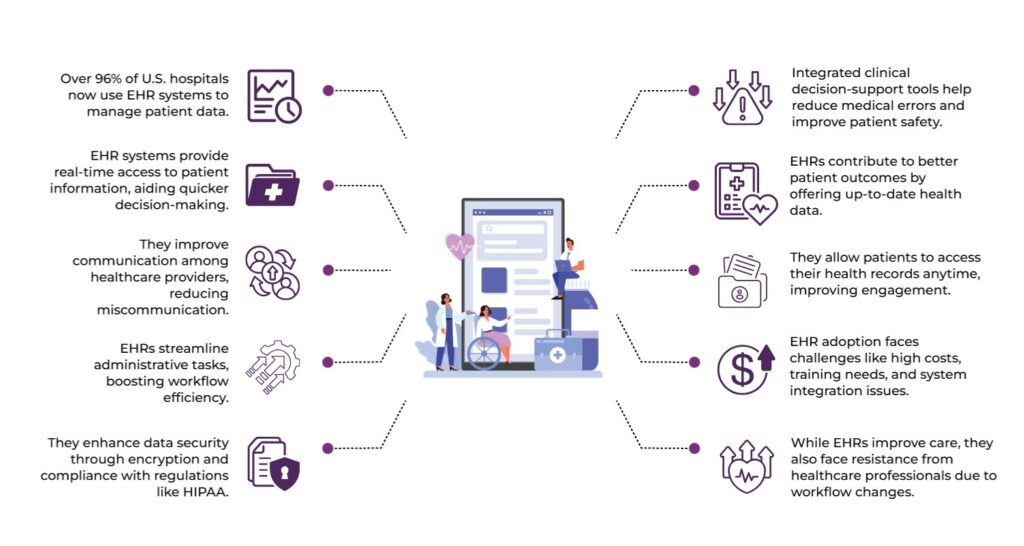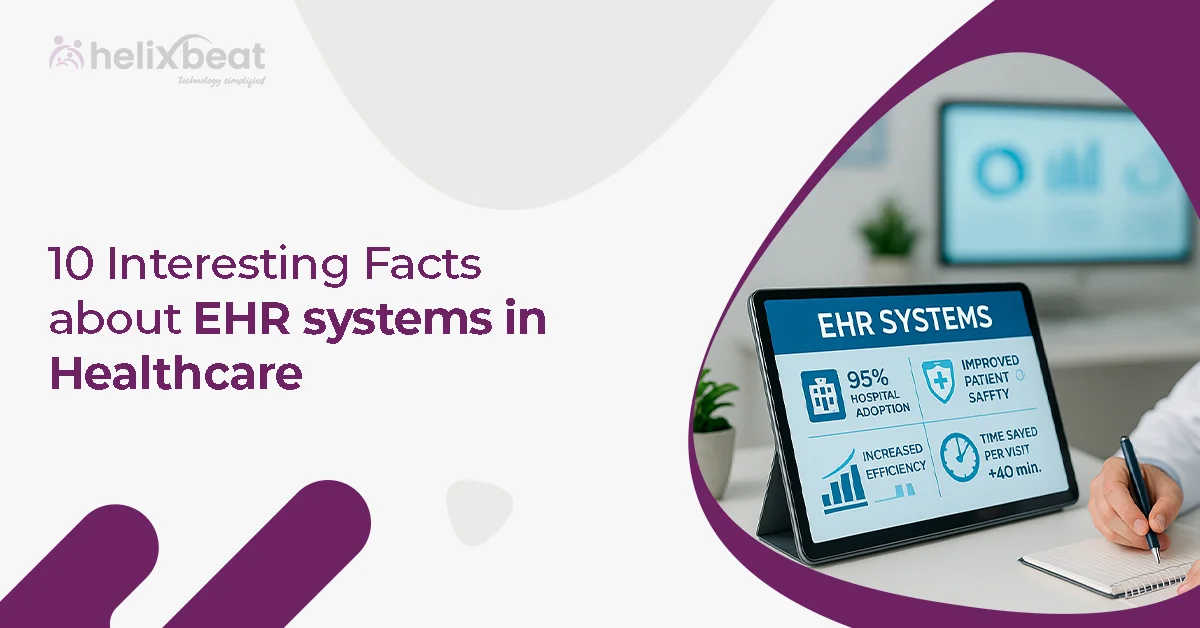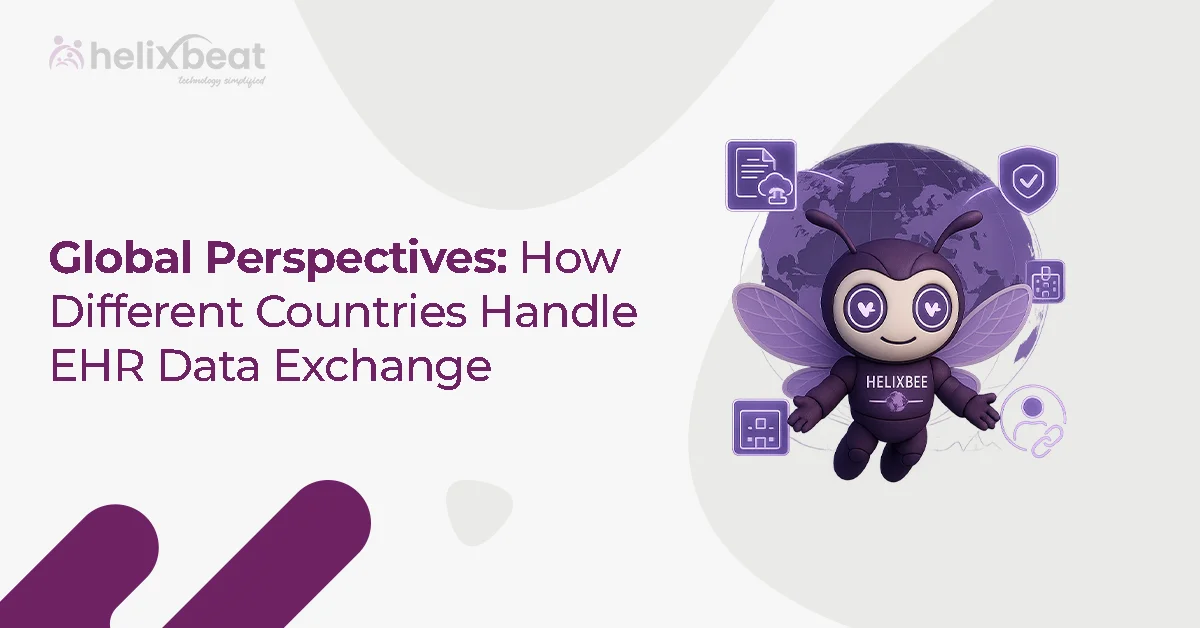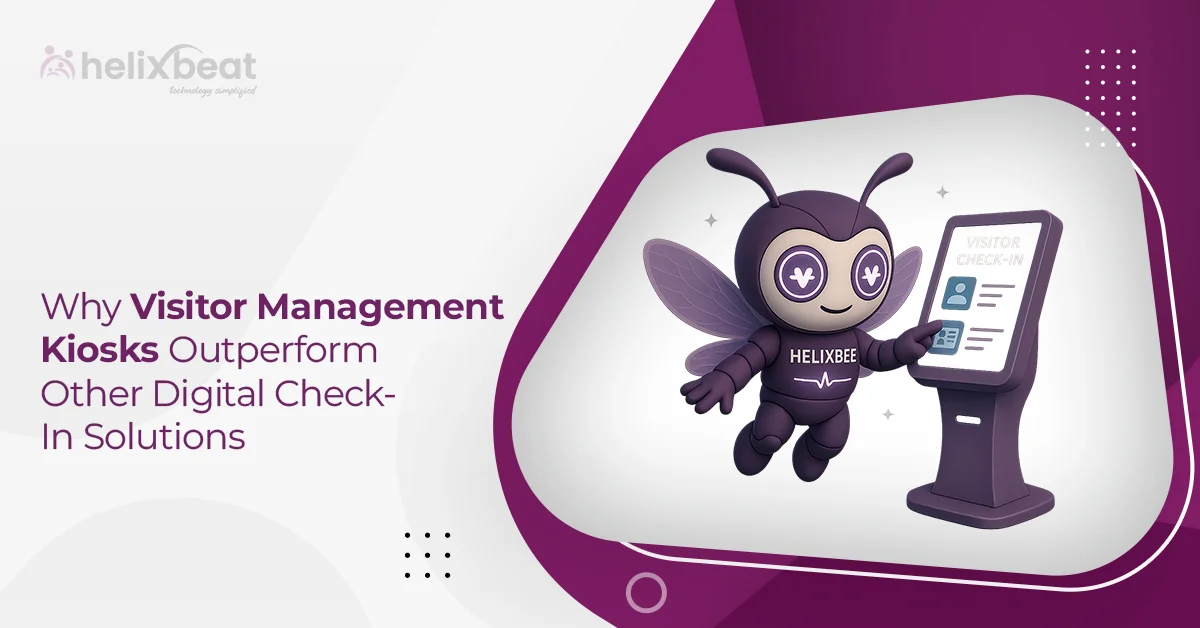Did you know that over 96% of U.S. hospitals use Electronic Health Record (EHR) systems to manage patient data? These systems are essential for modern healthcare as they enhance patient care, streamline workflows, and ensure compliance.
By simplifying data management and improving communication between patients and providers, EHRs are transforming healthcare delivery. Let’s explore 10 intriguing facts about Electronic Health Record Systems.

Table of Contents
What are EHR Systems in Healthcare?
Electronic Health Record (EHR) represent the digital transformation of traditional paper medical charts used in healthcare. These systems are designed to collect, store, and manage patient data electronically, allowing healthcare providers to access and update records in real-time.
The purpose of EHR systems is multi-faceted:
Real-Time Access to Information
- Healthcare providers can instantly access a patient’s medical history and data from any location.
- This immediate access aids in quicker decision-making and more informed treatment plans.
- Reduces the likelihood of errors that may arise from missing or incomplete information.
Improved Communication
- EHRs enable seamless communication between various healthcare providers, including specialists, primary care doctors, and hospitals.
- Ensures that all providers have access to the most up-to-date and accurate patient information, preventing miscommunication and reducing duplication of tests.
Streamlined Workflow and Efficiency
- EHR systems automate many administrative tasks, such as appointment scheduling, billing, and insurance claims.
- Reduces time spent on paperwork, allowing healthcare professionals to focus more on patient care.
- Facilitates quicker document retrieval and management, leading to faster processing of patient information.
Enhanced Data Security and Privacy
- EHRs are equipped with encryption, password protection, and audit trails to secure patient information.
- Only authorized individuals can access sensitive data, maintaining confidentiality and compliance with regulations like HIPAA.
- Reduces the risk of physical damage or loss of paper records, ensuring data integrity.
Decision Support and Alerts
- EHR systems are integrated with clinical decision-support tools that assist healthcare providers in making informed choices.
- Alerts about potential drug interactions, allergies, or preventive care reminders help reduce errors and enhance patient safety.
- Guides providers in following best practices and evidence-based medical guidelines.
Better Patient Outcomes
- EHRs enable faster diagnoses and treatments by providing healthcare professionals with complete, up-to-date medical histories.
- Reduces the risk of errors and delays in care due to missing or outdated information.
- Promotes a more coordinated and holistic approach to patient care, improving overall outcomes and patient satisfaction.
CTA: Want to improve patient care with EHR? Let’s discuss how!
The Core Functions of EHR Systems
(Note: Please create an infographic based on the table given below.)
| Core Function | Description |
| Data Collection | Collects comprehensive patient data, including medical history, allergies, lab results, medications, and immunizations. |
| Clinical Decision Support | Provides alerts, reminders, and evidence-based recommendations to assist healthcare providers in making informed decisions. |
| Electronic Prescribing (e-Prescribing) | Allows healthcare providers to electronically send prescriptions to pharmacies, reducing errors and enhancing efficiency. |
| Patient Information Management | Manages and organizes patient demographic information, medical history, and insurance details in a digital format. |
| Health Information Exchange (HIE) | Enables secure sharing of patient information across different healthcare providers and organizations for better coordination. |
| Medication Management | Tracks prescribed medications, dosages, and ensured compatibility, helping to prevent drug interactions or allergies. |
Benefits of EHR Systems for Patients
Electronic Health Records (EHRs) are transforming healthcare delivery, providing patients numerous advantages that enhance their healthcare experience. Here are the key benefits of EHR systems for patients:
Easy Access to Health Information
- Patients can access their medical records online anytime, anywhere.
- Facilitates more active participation in their healthcare management.
Improved Care Continuity
- EHRs ensure healthcare providers have access to up-to-date patient information across different facilities.
- Reduces the need for patients to repeat their health history to multiple providers.
Enhanced Communication Between Patients and Healthcare Providers
- Direct communication via patient portals for messages, appointment scheduling, and prescription refills.
- Reduces wait times and enhances the overall healthcare experience.
Reduced Risk of Errors
- Built-in decision support tools help reduce medication errors and other risks.
- Minimizes the chances of duplicate tests or incorrect prescriptions.
Better Coordination of Care
- Healthcare providers can easily share critical health information, ensuring effective team collaboration.
- Ensures patients receive comprehensive, well-coordinated care across all healthcare providers.
Empowerment and Ownership of Health Information
- Patients can track their health progress, set goals, and become more involved in their care.
- Enables sharing of records with caregivers or family members for better health management.
Faster and More Accurate Diagnosis
- EHRs provide doctors with a complete view of the patient’s health history, enabling quicker diagnoses.
- This results in faster treatment and improved recovery times for patients.
Challenges Faced in EHR System Implementation
Implementing Electronic Health Record (EHR) systems offers various benefits, such as improved patient care and streamlined administrative tasks. However, challenges can arise that hinder successful adoption and effectiveness, varying by the size of the healthcare facility and its resources. Here are some key obstacles faced by many healthcare providers:
High Costs of EHR Implementation
The high initial cost is among the most significant barriers to EHR adoption. The upfront expense of purchasing and implementing an EHR system can be prohibitive for many healthcare facilities, especially smaller practices or rural hospitals. This includes hardware, software, and IT infrastructure costs and the fees associated with software customization, integration, and ongoing maintenance.
- Implementing an EHR system requires purchasing the software and hardware (servers, computers, etc.), which can be expensive.
- EHR systems require continuous updates, security patches, and technical support, which add to the long-term costs.
- When switching from paper records to digital systems, hidden costs may also exist related to system downtime, temporary workflow disruptions, and potential data migration issues.
Training Requirements and Learning Curves
EHR systems are complex and require specialized training for healthcare professionals. Ensuring everyone from doctors and nurses to administrative staff is adequately trained to use the system is time-consuming and resource intensive.
- Staff must be trained to use the system effectively, often setting aside time during working hours for educational sessions. This can lead to reduced productivity in the short term as employees become familiar with the new system.
- Many healthcare professionals are accustomed to paper-based or older electronic systems. Switching to a new EHR system can be overwhelming, and some staff may resist the change due to a perceived increase in workload or fear of technology. This resistance can slow down the adoption process.
- EHR systems are regularly updated with new features, requiring ongoing education and retraining. This continuous need for training can be seen as an additional burden by healthcare staff.
Data Security and Privacy Concerns
The digital nature of EHR systems introduces concerns about data security and patient privacy. Healthcare organizations are responsible for safeguarding sensitive patient information, and any security breach can lead to significant consequences, including reputational damage, regulatory penalties, and loss of patient trust.
- EHR systems are susceptible to cyberattacks, such as ransomware and hacking, which can compromise the integrity and confidentiality of patient data. Ensuring the system is secure and compliant with industry standards (like HIPAA in the U.S.) requires significant investment in cybersecurity infrastructure.
- If an EHR system is not adequately secured, there is a risk of unauthorized access to patient data. This can result in financial losses, legal issues, and damage to the facility’s reputation.
- Healthcare facilities must ensure that their EHR systems comply with data privacy regulations, which vary by country or region. This adds another layer of complexity to EHR systems’ implementation and ongoing use.
System Integration and Interoperability
Many healthcare organizations face challenges when integrating EHR systems with other existing technologies. Hospitals and clinics often use various systems for different functions such as scheduling, billing, and lab tests so ensuring the EHR can seamlessly exchange information with these systems is crucial.
- If the EHR system is not adequately integrated with other healthcare management systems, it can create silos of information, leading to inefficiencies, errors, and incomplete patient records.
- Many EHR systems are not designed to work together seamlessly, especially if healthcare providers use different systems. This can hinder the exchange of patient information between practices, hospitals, and specialists, resulting in fragmented care.
- Healthcare facilities may need to customize their EHR system to meet their organization’s unique needs, which can be time-consuming and costly.
Workload Disruptions During Transition
Transitioning from paper records or legacy systems to an EHR system can disrupt daily workflows and affect productivity. During the implementation phase, healthcare staff may experience frustration as they adjust to the new system, leading to potential delays in patient care and administrative tasks.
- When switching to an EHR system, there is often a downtime while the system is being installed, configured, and tested. During this time, medical records and other vital patient data may be temporarily inaccessible, potentially leading to delays in care.
- Initially, EHR systems can require more data entry and administrative work. For example, healthcare providers may need to manually input data into the system until the system is fully operational, which can increase their workload and impact patient care.
Provider Resistance and Workflow Changes
Healthcare professionals, particularly doctors and nurses, may resist using EHR systems due to concerns over workflow changes. Many healthcare providers are used to traditional methods and may feel that an EHR system complicates their day-to-day tasks.
- Healthcare professionals often face time pressure to attend to multiple patients. They may feel that entering data into an EHR system wastes valuable time, which could otherwise be spent on patient care.
- Some providers worry that spending time on computers and entering data could detract from personal patient interaction, which is often considered an essential part of the healing process.
FAQs
What is the greatest advantage of an EHR system?
The greatest advantage of an EHR system is the improved quality of patient care through better coordination, reduced errors, and enhanced decision-making capabilities.
How does an EHR system improve patient care?
EHR systems allow healthcare providers to access complete patient histories quickly, leading to faster diagnoses and personalized treatments.
What are the core functions of EHR?
The core functions include data entry, electronic prescribing, decision support, patient tracking, and more, all aimed at improving the efficiency of healthcare delivery.
What is the most used EHR system in the world?
Epic Systems, Cerner, and Allscripts are some of the most widely used EHR systems globally.
What are the disadvantages of EHR?
Disadvantages include high initial costs, a learning curve for staff, and potential data security risks.
How do EHR systems benefit patients?
They provide patients with easy access to their medical information, improve communication with healthcare providers, and ensure continuity of care.
How does an EHR system enhance healthcare efficiency?
It reduces paperwork, speeds up data processing, and reduces errors, leading to better resource management and cost efficiency.
What are the future trends in EHR systems?
Future trends include AI integration, blockchain for security, and enhanced interoperability among different EHR systems.














